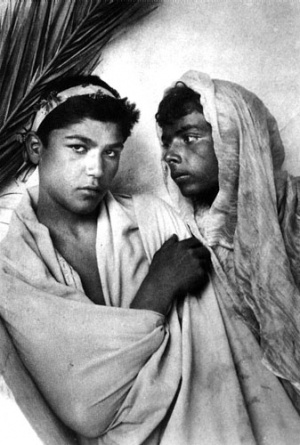Wilhelm von Gloeden: Difference between revisions
fixed typos |
Modified one of the categories of the page |
||
| (7 intermediate revisions by one other user not shown) | |||
| Line 1: | Line 1: | ||
[[Image:Wilhelm von Gloeden.jpg|thumb|right|Self-portrait of Wilhelm von Gloeden in 1891.]] | [[Image:Wilhelm von Gloeden.jpg|thumb|right|Self-portrait of Wilhelm von Gloeden in 1891.]] | ||
'''Baron Wilhelm von Gloeden''' ( | '''Baron Wilhelm von Gloeden''' ([[September 16]], [[1856]] – [[February 16]], [[1931]]) was a German photographer and [[boylover]] who worked mainly while an [[expatriates|expatriate]] in [[Italy]]. He is mostly known for his pastoral nude studies of [[Sicily|Sicilian]] boys. | ||
== Life and work == | == Life and work == | ||
| Line 6: | Line 6: | ||
Von Gloeden was a minor German aristocrat born in Mecklenburg in September 16, 1856 who, suffering from what appears to have been tuberculosis, came to [[Taormina]] in [[Sicily]] in 1876. He was wealthy and provided a considerable economic boost in this comparatively poor region of [[Italy]], which might explain why the homosexual aspects of his life and work were generally tolerated by the locals. | Von Gloeden was a minor German aristocrat born in Mecklenburg in September 16, 1856 who, suffering from what appears to have been tuberculosis, came to [[Taormina]] in [[Sicily]] in 1876. He was wealthy and provided a considerable economic boost in this comparatively poor region of [[Italy]], which might explain why the homosexual aspects of his life and work were generally tolerated by the locals. | ||
Not all von Gloeden's photographs were nudes. The ones that garnered the most widespread attention in Europe and overseas were usually relatively chaste, featured clothes like togas and generally downplayed their homoerotic implications. More explicit photos in which the boys were nude and which, because of eye contact or physical contact, were more sexually suggestive were traded by the Baron "under the counter" to close friends. | Not all von Gloeden's photographs were nudes. The ones that garnered the most widespread attention in Europe and overseas were usually relatively chaste, featured clothes like togas and generally downplayed their [[homoerotic]] implications. More explicit photos in which the boys were nude and which, because of eye contact or physical contact, were more sexually suggestive were traded by the Baron "under the counter" to close friends. | ||
[[Image:Portrait of two boys by Wilhem von Gloeden.jpg|thumb|left|A portrait of two boys by von Gloeden.]] | [[Image:Portrait of two boys by Wilhem von Gloeden.jpg|thumb|left|A portrait of two boys by von Gloeden.]] | ||
| Line 25: | Line 25: | ||
== External links == | == External links == | ||
*[http://vongloedengayhistory.free.fr Biography and gallery of his work] | *[http://vongloedengayhistory.free.fr Biography and gallery of his work] | ||
[[Category: | {{DEFAULTSORT:Gloeden, Wilhelm von}} | ||
[[Category: | [[Category:20th-century boylovers|Gloeden, Wilhelm von]] | ||
[[Category:Photographer]] | |||
[[Category:1856 births|Gloeden, Wilhelm von]] | |||
Latest revision as of 18:03, 21 January 2019
Baron Wilhelm von Gloeden (September 16, 1856 – February 16, 1931) was a German photographer and boylover who worked mainly while an expatriate in Italy. He is mostly known for his pastoral nude studies of Sicilian boys.
Life and work
Von Gloeden was a minor German aristocrat born in Mecklenburg in September 16, 1856 who, suffering from what appears to have been tuberculosis, came to Taormina in Sicily in 1876. He was wealthy and provided a considerable economic boost in this comparatively poor region of Italy, which might explain why the homosexual aspects of his life and work were generally tolerated by the locals.
Not all von Gloeden's photographs were nudes. The ones that garnered the most widespread attention in Europe and overseas were usually relatively chaste, featured clothes like togas and generally downplayed their homoerotic implications. More explicit photos in which the boys were nude and which, because of eye contact or physical contact, were more sexually suggestive were traded by the Baron "under the counter" to close friends.

In total the Baron took over 3,000 images which were widely disseminated due to new printing technologies that enabled the mass reproduction and sale of his work in postcard form.
After his death in February 16, 1931, von Gloeden left most of his works to one of his models, Pancrazio Buciunì, also known as "il Moro" ("the Moor") for his North African looks. Il Moro had been von Gloeden's lover since the age of fourteen, when he had first joined the household of the Baron.
In 1936, over 2,500 of the pictures were destroyed by Mussolini's police under the allegation that they constituted pornography. Most of the surviving images therefore come from private collections.
Further reading
- Russell, Bruce. "Wilhelm Von Pluschow and Wilhelm Von Gloeden: Two Photo Essays," Studies in Visual Communications 9, no. 2 (1983): 57-81.
- Peyrefitte, Roger. Les Amours Singulières (Paris: Jean Vigneau, 1949)
- Weiermair, Peter. Wilhelm Von Gloeden: Erotic Photographs (Cologne: Taschen Verlag, 1994)
- Pohlmann, Ulrich. Wilhelm von Gloeden: Taormina (München: Schirmer Mosel, 1998)
- Goldman, Jason. "Gloeden, Wilhelm von, Baron (1856-1931)" in glbtq: An Encyclopedia of Gay, Lesbian, Bisexual, Transgender, and Queer Culture, ed. Claude J. Summers (Chicago: 2002)